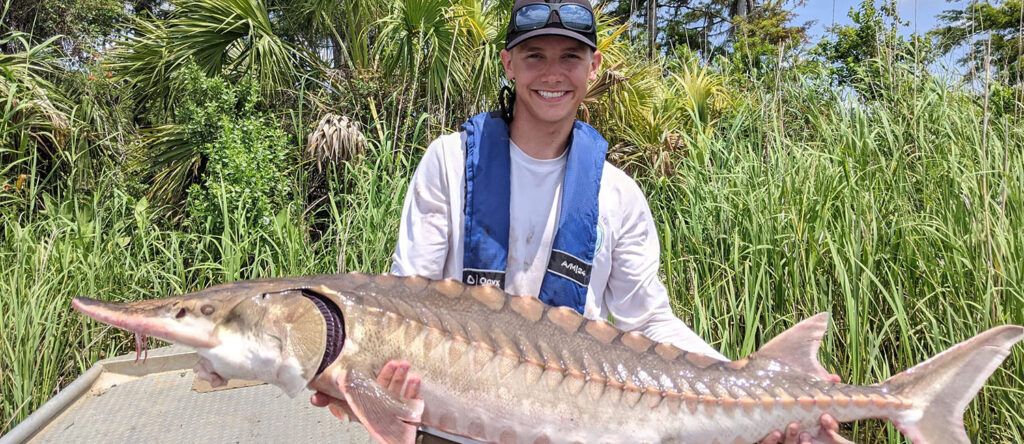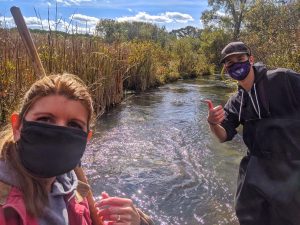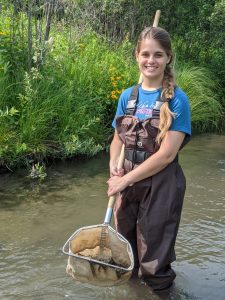
Austin Draper’s love of fish led him to a career in water sciences.
Austin Draper never considered a career in freshwater science. Although he was an extremely curious kid — and asked a lot of questions about nature, particularly fish — he struggled academically in high school. After graduation, he attended community college to explore his interests.
When he transferred to UW-Whitewater as a junior, he chose Biology with an emphasis in Ecology, Evolution and Behavior, but he still couldn’t quite envision his career plan. A faculty member recognized Draper’s passion for science and encouraged him to apply for a research position in Associate Professor Elisabeth Harrahy’s lab.

Elisabeth Harrahy and Austin Draper in the field.
Draper is now earning a master’s degree in Coastal Sciences from the University of Southern Mississippi where he is studying the highly threatened Gulf sturgeon. His future plans include earning a PhD and teaching science at a university.
“Getting into the lab helped me understand how to do science — what the process is for getting funding, preparing water samples, doing the tests and analysis, getting involved in the backend of the statistics,” he says. “The biggest benefit, though, was working with someone like Dr. Harrahy. She was a great mentor and she really helped me develop myself.”
His position in Harrahy’s lab was funded by a grant from the Freshwater Collaborative of Wisconsin (FCW) to study neonicotinoid insecticides, which are commonly used in agriculture in Wisconsin. Because these insecticides are often applied to seeds rather than sprayed broadly on crops, they initially weren’t considered a potential water contaminant. However, recent studies by the Wisconsin Department of Agriculture, Trade and Consumer Protection (DATCP) have detected neonicotinoids in groundwater and stream water, particularly in the Central Sands region of Wisconsin. These insecticides have also been shown to kill honeybees and other pollinators.
Harrahy and collaborator Tisha King-Heiden, a biology professor at UW-La Crosse, had received a grant from the DATCP to study neonicotinoid insecticides. Harrahy was studying the effects of thiamethoxam and imidacloprid (two of the neonicotinoids) on aquatic invertebrates, while King-Heiden was evaluating their toxicity in fish.
“The Wisconsin Department of Agriculture, Trade and Consumer Protection is responsible for registering pesticide use in the state and they are really concerned about these insecticides,” Harrahy says.
She adds that both projects address two of Wisconsin’s Grand Water Challenges: agricultural water management, and water quality safety and emerging contaminants. The grants from the Freshwater Collaborative allowed the two researchers to each hire an undergraduate to work in their labs during the summer.
“Undergraduates want to do research and get experience, but they also need to make money during the summer,” Harrahy says. “The beauty of these grants geared toward undergrads is they can work full-time in the lab. They don’t have to work a non-science job. And it gives them experience to know what they want to do early on.”
Draper, who graduated in December 2020, worked in the lab for two summers and volunteered during the school year. He worked closely with another student who was supported by a UW-Whitewater Summer Undergraduate Research Fellowship grant. They met virtually with students in King-Heiden’s lab so they could share their work.
In addition, students in both labs participated in a virtual meeting with Mike Miller, a fisheries biologist with the Wisconsin Department of Natural Resources (DNR), who talked about current concerns related to neonicotinoids in streams and challenges in assessing their effects in the field. Miller also talked to the students about his career path and what it is like to work for the Wisconsin DNR.
After Draper graduated, Harrahy hired Faune Fisher, an Environmental Science major who will present her piece of the research at Research in the Rotunda next spring. Although COVID hampered sample collection and testing, the students gained skills that will translate to working in any lab, learned how to present their research and explored career paths.

Faune Fisher at Bluff Creek.
The project showed that both thiamethoxam and imidacloprid can be acutely toxic to amphipods and water fleas at high concentrations (higher than currently being detected in Wisconsin waters), and that chronic exposure can lead to reductions in growth of amphipods and reductions in reproduction of water fleas.
Results of the study were shared at the Wisconsin Chapter of the American Water Resources Association annual meeting and will be summarized in a final report to DATCP. The data will help governmental agencies and industries better understand the risks of neonicotinoid pesticides and inform the development of surface water quality criteria.
“Having these kinds of grants is really valuable for everyone involved,” Harrahy says.
See more Freshwater Collaborative of Wisconsin research stories.
